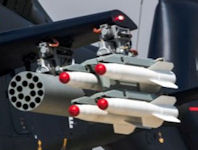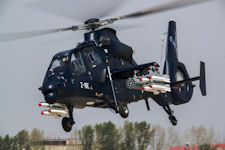AKD-X helicopter air-to-surface missile - 2020
 China Aviation News reported that a new type of helicopter air-to-surface missile was successfully tested at a test base in Alashan, Inner Mongolia. The emergence of this new type of missile has pushed China’s helicopter airborne ammunition level to the world’s leading level. This report is very vague. It did not mention the missile model, the range of the missile, the power of the warhead, the guidance method, etc., but it gave a more interesting central idea, that is, the new type of missile is capable of off-zone strike and compound.
China Aviation News reported that a new type of helicopter air-to-surface missile was successfully tested at a test base in Alashan, Inner Mongolia. The emergence of this new type of missile has pushed China’s helicopter airborne ammunition level to the world’s leading level. This report is very vague. It did not mention the missile model, the range of the missile, the power of the warhead, the guidance method, etc., but it gave a more interesting central idea, that is, the new type of missile is capable of off-zone strike and compound.
Once fully operational, the new ATGM could replace the AKD-9 and AKD-10 anti-tank missiles and YJ-9 anti-ship missiles already in service. Unlike the earlier versions, the new ATGM is not limited to use with just one type of helicopter, making it similar to the US AGM-114 “Hellfire” series. The doubling of the range is significant. In order to further improve the survival of the contemporary helicopter gunship battlefield, in addition to enhancing its own stealth performance, the most direct and effective way is to significantly improve its effective range of ground strikes.
The main detection system of the Zhi-10 is the photoelectric detection system under the nose, which consists of a forward-looking infrared detection system, a CCD camera and a laser ranging/target indication system. The main airborne weapon is the AKD-10 laser. Semi-active guided anti-tank missiles, with a maximum range of about 8 kilometers, can attack outside the range of the opponent’s light air defense weapons. From the overall tactical and technical indicators, the combat capability of the Zhi-10 is roughly equivalent or similar to that of European Tiger armed helicopters.
There is still a big gap from the AH-64D, especially the latest AH-64E. One of the obvious gaps may be the lack of millimeter wave radar. Chinese sources have suggested that China may be developing a millimeter-wave radar-guided version of the AKD-10 air-launched anti-tank missile manufactured by China North Industries Corporation. Blue Arrow-21 missile, the size of the missile is further increased on the basis of the original "Blue Arrow 7", the size is close to the US "Maverick" missile, the guidance method is currently semi-active laser guidance, the missile's power and range are better than the existing "Blue Arrow-7" (AKD-10) missile has been greatly improved.
Gunships are the "natural enemies" of tanks and armored vehicles. They are considered to be "a tree as high as a tree" strategic weapon and have become the most powerful attack platform for Army aviation. However, armed helicopters also face a severe survival crisis on the battlefield. The threats to armed helicopters include field air defense systems, individual air defense missiles, armed helicopters, anti-tank missiles, and light weapons. The main reasons for Wuzhi’s fragility are its low flight altitude, slow speed and thin armor, especially when it is difficult for the regular army to function. Considering that the cost of modern armed helicopters is not much lower than that of fighter jets, in fact, they cannot afford to lose at all.
The main role of helicopters is to attack armored targets, and the anti-tank missiles they are equipped with are "fangs". The missile is the most classic weapon in modern weapons. It has a long range, high power, and accurate strike. It can be said that it completely rewrites the situation of war. In response to these outstanding advantages, experts have also begun to use new technologies to transform existing missiles. The development of new materials technology, simple fire control technology and guidance technology provide technical basis for new anti-tank missiles. At present, the U.S. Javelin is the only fourth generation anti-tank missile with mature application. However, in the future, there will be a number of technological breakthroughs in anti-tank missiles.
The first is the development of new warhead to enhance lethality. The second is the change of attack mode to improve armor penetration power. The armor protection on the top of the tank is relatively weak, so hedgehopping upper armor attack can significantly increase the probability of destruction.
The third is the development of dual/multi-mode guidance technology to enhance anti-jamming capability. In this way, the missile will have a "fire and forget" capability and can increase accuracy under bad weather conditions and in night operations. The fourth is the development of ultra-high-speed kinetic energy anti-tank missiles. Ultra-high-speed kinetic energy missiles have strong lethality and thus can "hit and destroy."
In addition, the development of multi-purpose anti-tank missiles and the development of high-performance engine to expand the attack radius are also important future directions. The developing trend of anti-tank missiles will be all-weather, multi-purpose, low cost and intelligent. In the future, anti-tank missiles will have a wider range of usage.
 In recent years, the emergence of unmanned attack aircraft has made the status of helicopters embarrassing. The main reason is that Wu Zhi is facing the problems of low flying altitude, poor battlefield survivability, and high cost. The emergence of this missile means that the armed helicopter has ushered in its second spring. Because this missile will be heavier, it is entirely possible that China will continue to develop the level 10 heavy armed helicopter. More importantly, the same type of missiles can also be installed on armored vehicles and unmanned helicopters, further enhancing the anti-armor combat capabilities of the entire army.
In recent years, the emergence of unmanned attack aircraft has made the status of helicopters embarrassing. The main reason is that Wu Zhi is facing the problems of low flying altitude, poor battlefield survivability, and high cost. The emergence of this missile means that the armed helicopter has ushered in its second spring. Because this missile will be heavier, it is entirely possible that China will continue to develop the level 10 heavy armed helicopter. More importantly, the same type of missiles can also be installed on armored vehicles and unmanned helicopters, further enhancing the anti-armor combat capabilities of the entire army.
A new helicopter air-to-surface missile developed by China was also successfully tested on 22 June 2020. The appearance of this missile has pushed the level of airborne ammunition for Chinese helicopters to the world. Leading level. The new missile has the ability to strike outside the zone, adopts advanced technologies such as compound guidance, and has the characteristics of long range, high power and strong anti-jamming ability. It will be used to replace the original AKD-9, AKD-10 and Yingzha-9 of Wuzhi-10.
The helicopter air-to-ground missile developed by China has the world's leading range, which means that its range will exceed the 32 kilometers of Spike-NLOS, which may be between 35-40 kilometers. It is also a non-line-of-sight attack missile. The helicopter launching an attack at this distance can keep itself away from the opponent's field anti-aircraft missiles, portable anti-aircraft missiles, and anti-aircraft guns, and can even be launched behind obstacles, thus possessing the ability to "strike cattle", that is, to obtain an attack outside the defense zone. ability.
The emergence of this kind of missile means that the combat mode of armed helicopters has been completely changed. When attacking opponents, they will rely more on data links for target indication, which can be used by scouts, UAVs, reconnaissance helicopters, fighters, early warning aircraft and satellites To provide target information, the missile has a two-way data link and can conduct "A launch and B guidance" to ensure the safety of the helicopter. The beyond-horizon attack missile will also have the ability to automatically identify a predetermined target, and can be ignored after launch.
The longest range of airborne anti-tank missiles in the world is the Israeli model, with a maximum range of 25 kilometers. The missile uses passive photoelectric guidance technology and data link transmission. With such a long-range weapon, the aircraft can completely ignore any enemy air defense missiles. , You only need to hide far behind the mountain, but this kind of missile’s ultra-long range has also brought huge troubles. It is impossible to get accurate information about targets 25 kilometers away by virtue of the local sighting system. Use off-aircraft information, either use drones for early reconnaissance, or use reconnaissance helicopters to approach and quickly reconnaissance, quickly retreat, and quickly send the target location and images to the remote carrier platform through the data link, so that the carrier can not directly look at the target In case of launching, this mode is also called blind launch.
The emergence of new types of ammunition has also brought even greater surprises to armed helicopters: the range is so far that the enemy cannot counterattack, but there are also huge hidden dangers. The AKD-10 air-to-surface missile with a range of 7 kilometers weighs more than 40 kg. To overcome the enemy's air defense missile system attack, the maximum range must exceed 15 kilometers, or even reach 20 kilometers. Such a large range requires longer missile engine combustion time, longer missile length, and the maximum weight is likely to reach 100 kg. This is for helicopters. The number of weapons mounted has a serious impact, and it is very likely that only 4 missiles can be mounted to attack.
Another problem is the cost of the missile. The new missile is very likely to adopt the new millimeter wave, infrared, and laser semi-three-in-one compound mode, plus the inertial navigation Beidou satellite guidance compound mode, which can be very difficult to interfere, but such a complex guidance system In addition to the huge increase in the size and weight of missiles, the cost of missiles will rise wildly. This is extremely unfavorable for a large number of equipment. Designers must think of appropriate methods to minimize the cost to meet the attack needs of many targets on the battlefield.
In recent decades, the biggest challenge the Army has received is that, excluding the Air Force’s aircraft, the opponent’s armed helicopter is the most terrifying enemy. No matter how simple the technology is, it is very difficult to deal with, so the whole world Vigorously strengthen the research on combating armed helicopters. The result is a variety of antiaircraft artillery, shoulder-mounted missiles, and accompanying light air defense missile systems. The air defense system upgrades have also promoted the progress of armed helicopters. This time the missile range has doubled, giving the defense side a Difficult questions will be difficult to answer for a while.
|
NEWSLETTER
|
| Join the GlobalSecurity.org mailing list |
|
|
|

